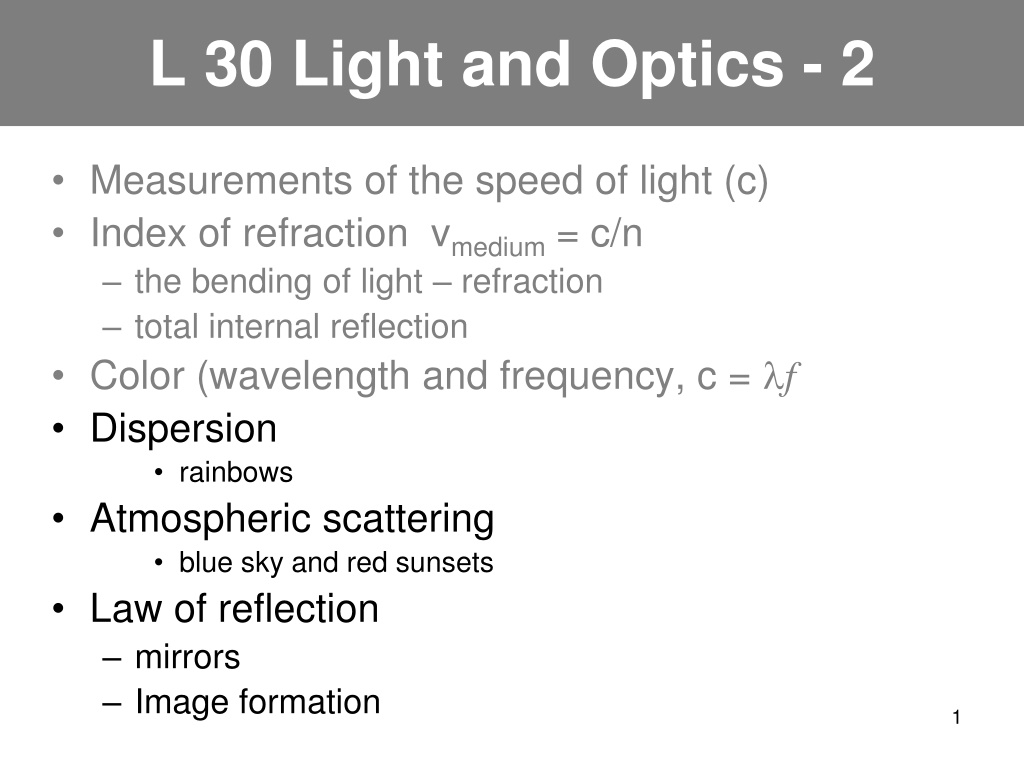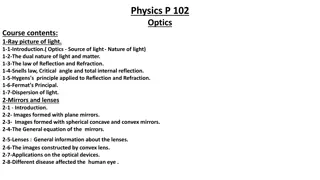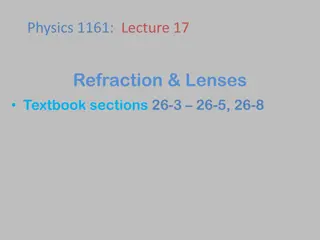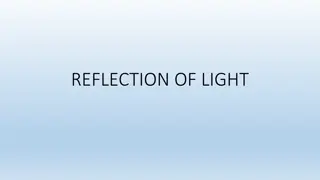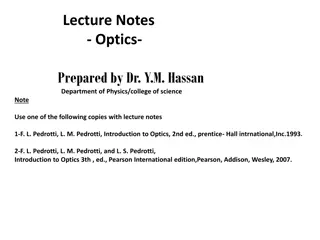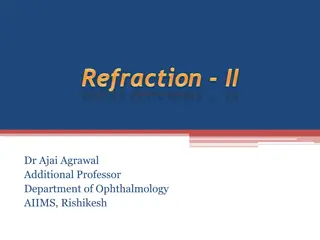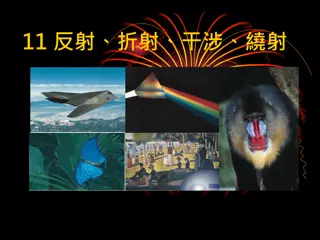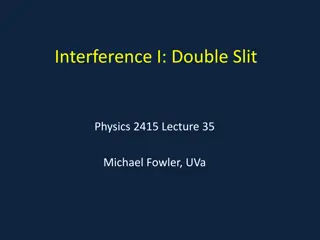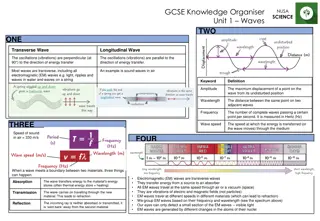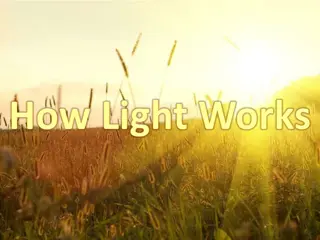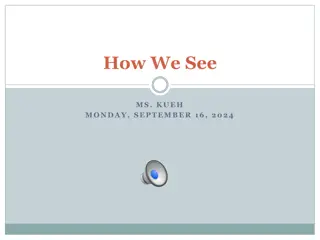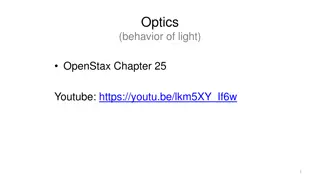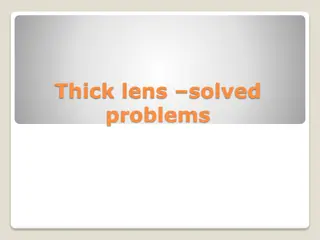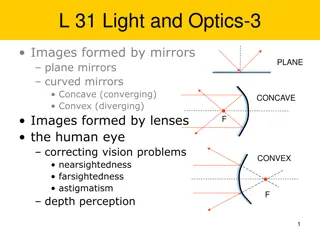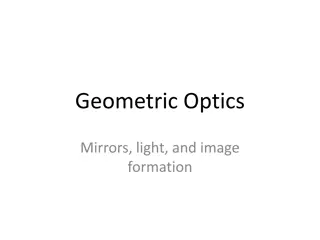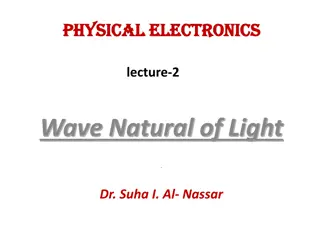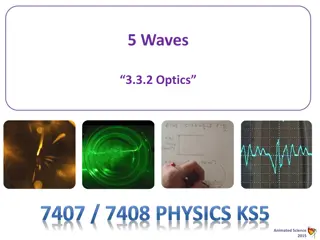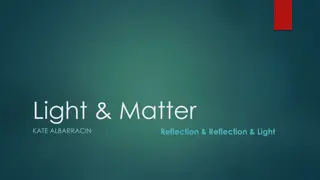Exploring Light and Optics: Reflection, Refraction, and Phenomena
Explore the fascinating world of light and optics, delving into topics like the speed of light, index of refraction, reflection, refraction, dispersion, rainbows, atmospheric scattering, and more. Understand how different colors of light are refracted, leading to phenomena such as rainbows and blue skies. Discover the science behind why the sky appears blue and sunsets are red, as well as the mechanisms of total internal reflection and image formation.
Download Presentation

Please find below an Image/Link to download the presentation.
The content on the website is provided AS IS for your information and personal use only. It may not be sold, licensed, or shared on other websites without obtaining consent from the author. Download presentation by click this link. If you encounter any issues during the download, it is possible that the publisher has removed the file from their server.
E N D
Presentation Transcript
L 30 Light and Optics - 2 Measurements of the speed of light (c) Index of refraction vmedium = c/n the bending of light refraction total internal reflection Color (wavelength and frequency, c = f Dispersion rainbows Atmospheric scattering blue sky and red sunsets Law of reflection mirrors Image formation 1
Reflection and refraction at a surface Index of refraction n = c/v > 1 Normal line Incident Light ray reflected Light ray AIR GLASS refracted Light ray 2
VISIBLE LIGHT COLOR WAVELENGTH or FREQUENCY Wavelength Frequency = c = speed of light e.g., 6x1014 Hz x 500x10-9 m = 3x108 m/s 3
The index of refraction (n) depends of the color (wavelength) of the light color red orange yellow green blue violet Wavelength (nm) 660 610 580 550 470 410 n 1.520 1.522 1.523 1.526 1.531 1.538 1 nanometer (nm) = 1 10 9 m 4
Different colors are refracted (bent) by different amounts, this phenomenon is called dispersion Blue light is bent more than red light, because n is larger for blue light contains all wavelengths (colors) white light red glass prism blue 5
The rainbow Rainbows are caused by dispersion of sunlight from water droplets which act as tiny prisms 6
Why is it a rain BOW ? 42 The rain drops must be at just the correct angle (42 ) between your eyes and the sun to see the rainbow. This angle is maintained along the arc of a circle. 7
Atmospheric scattering Why is the sky blue and sunsets red? It is due to the way that sunlight is scattered by the atmosphere (N2 and O2) Scattering atoms absorb light energy and re-emit it, but not at the same wavelength Sunlight contains a full range of wavelengths in the visible region 8
Atmospheric scattering: blue sky Short wavelengths are scattered more than long wavelengths Blue light (short) is scattered 10 times more than red light The light that we see in the sky when not looking directly at the sun is scattered blue light 9
Atmospheric scattering: red sunset At sunset, the sun is low on the horizon When looking at the sun it appears red because much of the blue light is scattered out leaving only the red 10
Why are clouds white? Clouds consist of water droplets and very small ice crystals The water droplets and ice scatter the sunlight Scattering by water and ice (particles) is very different from scattering by molecules The atoms are smaller than the wavelength of light, but the ice and water particles are larger Scattering by particles does not favor any particular wavelength so the white light from the sun is scattered equally clouds are white! 11
Mirrors reflection Light does not pass through metal (e.g. Aluminum) Light is reflected at the surface Two types of reflection: diffuse and specular Rough surface Polished surface Specular reflection: Sharp image Diffuse reflection: Fuzzy or no image 12
The law of reflection normal reflected ray incident ray r i mirror The incident ray, reflected ray and normal all lie in the same plane, and The angle of reflection = angle of incidence r = i 13
image formation by plane mirrors object image The reflected rays are diverging when they leave the object so they will not come to a focus point; our eyes perceive the reflected rays as coming from a point behind the mirror this is called a virtual image A virtual image can be seen with our eyes but cannot be projected onto a screen (our eyes focus the diverging rays onto the retina) The image is the same distance behind the mirror as the object is in front of the mirror, and the image is the same height as the object 14
You only need a mirror half as tall as you are to see your whole self Homer s image Homer 15
The image of your right hand is your left hand AMBULANCE is printed backward so that you can read it correctly in your real-view mirror 16
Spherical or curved mirrors parallel light rays are focused to one point in front of the mirror Concave mirror focus parallel rays diverge from a focus point behind the mirror Convex mirror focus 17
Reflection from a curved surface CONCAVE Reflection at a curved surface is governed by the law of reflection angle of reflection equals angle of incidence. The direction of the normal changes from one point to another on a curved surface. CONVEX 18
Real image formed by a concave mirror OBJECT F IMAGE When the object is at a distance greater than the focal point, the reflected light rays meet at a point in front of the mirror, so the image is REAL; it is INVERTED and DIMINISHED in size. 19
Where is the light bulb? image of light bulb F light bulb f f A concave mirror will form a real image of an object placed at twice its focal length at a distance of twice the focal length. It will be inverted and the same size as the object. 20
Dish antennas signal from satellite detector at the focal point of the dish 21
Magnifying mirrors Homer s image Homer when something placed within the focus of a concave mirror, an enlarged, upright image is formed. this principle is used in a shaving or makeup mirror 22
Convex mirrors: wide angle view Object Image A convex lens provides a wide angle view. Since it sees more, the images are reduced in size. Passenger side mirrors are often of this type with the warning: Objects appear farther than they actually are. Because they appear smaller, they appear to be farther away. 23
